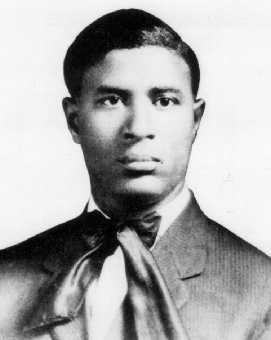As much as we dislike sitting at traffic lights, imagine a world where such devices didn’t exist. Chaos comes to mind – especially when you consider how inconsistently drivers behave at four-way stops, or even worse, at completely uncontrolled intersections. Yikes.
It was exactly 100 years ago today, on November 20, 1923, when Garrett Morgan received a patent for the traffic signal. He had been working on the design for over a year prior.

Backstory
Morgan was born in 1877 in Lexington, Kentucky and received a fifth-grade education. He found work in Cleveland making improvements to sewing machines and gained confidence in his abilities. Later, he came up with hair care products including pomade, oil stain, and hairbrushes. This was another brick in the foundation of where he wanted to go in life.
“He worked very hard in order to get where he got,” Garrett’s granddaughter Sandra said. “The adventurer turned into an entrepreneur.”

One of Morgan’s key inventions was a fire safety hood. It was constructed with a carbon filter pack which allowed for the recycling of air. He won an award in 1911 at the New York Safety Exposition, but he was not invited to be part of the programming even though his product was on display. In his absence, he hired someone to represent him. He was not deterred, and he continued to work. The hood (which essentially served as the precursor to modern-day gas masks) went on to be used in 1916 in the rescue of workers in Cleveland who were trapped in a tunnel following an explosion.
Traffic Signal Invention
Traffic was sheer pandemonium in the early 1900s. Horses, cars, pedestrians, and bicycles with no protocol whatsoever. Garrett Morgan’s traffic signal was not the first, but it was revolutionary. The design used three-way signage: It said stop, go, and caution. The caution sign was essentially intended to mean, “If you’re not in the intersection, don’t come in.”
The fundamental idea of the traffic signal has not changed dramatically since it was invented. It has changed in technology, but the premise remains the same as in 1923. One of Garrett Morgan’s three remaining signals is on display at the Smithsonian. His patent was eventually sold to General Electric.

Life Legacy
Garrett Morgan went on to create a newspaper called the Cleveland Call. In 1932, he decided to run for city council, and although he was not elected, this opened the door for dialogue between the minority and majority voting blocks. In his name, over a million dollars have since been given to scholarships.

Garrett Morgan passed away 60 years ago in 1963 at age 86. I connected with his granddaughter, Sandra, for some brief Q&A over the phone. She is currently the Director of External Affairs for Kent State University. Here was part of our dialogue:
- What do you recall about your grandfather?
I was less than two years old when he passed, so my recollections come from my father, Garrett Morgan Junior, who maintained my grandfather’s legacy and business operations. He made sure people knew about our father’s inventions and his civic engagement. My family instilled in me “the quest for excellence.”
- Has your grandfather’s legacy inspired your own aspirations and career path?
I’m not particularly inventive, but I think that that I’ve always tried to follow the example of being excellent. If you can do your best, why not? I have tried to live up to that standard, both professionally and personally.
- Do you ever wonder what kinds of ideas he would be coming up with if he were still alive today?
Were he able to see 2023 from 1963 or earlier, he would have come up with more improvements for transportation and transportation-related issues. It was something that intrigued him. He would be fascinated with the use of artificial intelligence (AI) and how that could be incorporated into new ideas and technology. His passion was education.
It was an honor to connect with Sandra, and I thank her for her time! With regard to transportation AI, Garrett Morgan might have been involved with self-driving automotive technology if he were around today.
The next time you’re sitting at a traffic light, take a moment to thank Garrett Morgan for his contribution to mobility that most of us use every single day!
